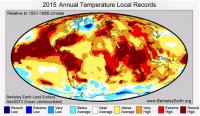-
Economic growth will not counterbalance increasing climate change-related damage
More than 50 percent of all weather-related economic losses on the globe are caused by damages due to tropical cyclones. New research finds that financial losses per hurricane could triple by the end of the century in unmitigated climate change, while annual losses could on average rise by a factor of eight. The researchers also concluded that economic growth will not be able to counterbalance the increase in damage.
-
-
Managing terrorism risk more complicated today
Managing terrorism risk today requires a combination of strategies and tactics that protect people, property, and finances. On the financial side, the choice is whether to retain or transfer the risk via insurance. But the changing pattern of terrorism risk has some companies questioning whether they are adequately insured for business interruption and related losses. And they wonder how to prepare for potential losses from cyber terrorism and other events.
-
-
How a new source of water is helping reduce conflict in the Middle East
Just a few years ago, in the depths of its worst drought in at least 900 years, Israel was running out of water. Now it has a surplus. This remarkable turnaround was helped by increasing conservation and re-use – but the biggest impact came from a new wave of desalination plants. Israel now gets 55 percent of its domestic water from desalination. Moreover, scientists and others look to desalination as a way to unite longtime enemies in a common cause.
-
-
USGS awards $3.7 million to advance ShakeAlert early warning system
The U.S. Geological Survey awarded approximately $3.7 million to six universities to support transitioning the ShakeAlert earthquake early warning system into a production system. Additionally, the USGS has purchased about $1.5 million in new sensor equipment to expand and improve the ShakeAlert system and awarded about $0.25 million in supplements to earlier agreements to three universities. These efforts, as well as internal work that the USGS is conducting, are possible because of $8.2 million in funding to the USGS Earthquake Hazards Program for ShakeAlert approved by Congress earlier this year.
-
-
Climate change to increase health risks from wildfires in U.S. West
A surge in major wildfire events in the western United States as a consequence of climate change will expose tens of millions of Americans to high levels of air pollution in the coming decades. The researchers estimated air pollution from past and projected future wildfires in 561 western counties, and found that by mid-century more than eighty-two million people will experience “smoke waves,” or consecutive days with high air pollution related to fires.
-
-
Assessing crop damage after extreme weather
The Philippines is host to six to nine tropical cyclones per year since 1970, and a citizenry that consumes more rice than it produces. The Philippines has for many years augmented its homegrown supply of rice with imports based on seasonal climate forecasts and agricultural production surveys. But import orders must be modified on the fly when extreme weather events exact a heavier toll on production than expected. New method to track the impact of typhoons and other natural disasters could enable more precise, timely delivery of food aid.
-
-
Atlantic hurricane season still expected to be strongest since 2012: NOAA
In its updated 2016 Atlantic Hurricane Season Outlook, NOAA calls for a higher likelihood of a near-normal or above-normal season, and decreases the chance of a below-normal season to only 15 percent, from the initial outlook issued in May. The season is still expected to be the most active since 2012. Forecasters now expect 70-percent chance of 12–17 named storms.
-
-
When disaster-response apps fail

When a terrorist struck Nice, France, on 14 July, a new French government app designed to alert people failed. Three hours passed before SAIP, as the app is called, warned people in and around Nice to the danger on the city’s waterfront during Bastille Day festivities. This aspect of the tragedy highlights an emerging element of disaster preparation and response: the potential for smartphone apps, social media sites, and information technology more broadly to assist both emergency responders and the public at large in figuring out what is happening and what to do about it. Sadly, disasters will keep occurring. But the future is bright for improved communication when they happen. It’s even possible that someday smartphones may be able to monitor the environment automatically and contribute to disaster alert systems on their own.
-
-
Climate change already accelerating sea level rise
Greenhouse gases are already having an accelerating effect on sea level rise, but the impact has so far been masked by the cataclysmic 1991 eruption of Mount Pinatubo in the Philippines, according to a new study. Satellite observations, which began in 1993, indicate that the rate of sea level rise has held fairly steady at about three millimeters per year. But the expected acceleration due to climate change is likely hidden in the satellite record because of a happenstance of timing: The record began soon after the Pinatubo eruption, which temporarily cooled the planet, causing sea levels to drop.
-
-
Seawalls, coastal forests in Japan help reduce tsunami damage
Researchers who analyzed a history of tsunamis along the Pacific coast of Japan’s Tohoku region have learned that seawalls higher than five meters reduce damage and death, while coastal forests also play an important role in protecting the public. Japan has embarked on a 10-year reconstruction project costing about 31.5 trillion yen, or about $255 billion, which includes the construction of tsunami seawalls along Tohoku’s Pacific coast. Critics of the program have voiced skepticism about the effectiveness of seawalls.
-
-
Worst flooding since 1998 leaves $33 billion economic toll in China

The new Global Catastrophe Recap report, covering July 2016 disasters, reveals that much of China endured substantial seasonal “Mei-Yu” rainfall that led to a dramatic worsening of flooding along the Yangtze River Basin and in the country’s northeast. Total combined economic losses were estimated at $33 billion. Meanwhile, the United States recorded six separate outbreaks of severe convective storms and flash flooding from the Rockies to the East Coast. Total combined economic losses were minimally estimated at $1.5 billion. Only 2 percent of China damage is covered by insurance, compared to nearly 70 percent for U.S. storms.
-
-
Build disaster-proof homes before storms strike, not afterward
There are many technologies we can use to make our buildings more hazard-resistant. But we are not using them as extensively as we should. Instead of designing a building to reduce potential damage from the hazards it may face over its lifetime, most construction projects focus on saving money up front. By choosing the lowest construction cost possible, homeowners, insurance agencies, and taxpayers may end up paying for it many times over when natural disasters occur. To prevent the devastation from another storm, twister, or quake, we need to make deep investments nationwide in mitigation now, before the next disaster strikes.
-
-
Making climate change summaries suitable for “grownups,” but accessible to policymakers
Researchers examined the writing and editing procedures by which the Intergovernmental Panel on Climate Change creates summaries of their findings for policymakers. Despite recent critiques that these summaries are too difficult for non-experts, the researchers found them comparable to reference texts in terms of reading comprehension level. Nevertheless, the researchers also suggest ways that the summary reports could be improved by using less jargon and more cohesive language to link the ideas they contain.
-
-
Adaptation to climate risks: Political affiliation matters
A new study reveals that those who affiliate with the Democratic Party have different views than those who vote Republican on the following issues: the likelihood of floods occurring, adopting protection measures, and expectations of disaster relief from the government.
-
-
2015 surpassed 2014 as the warmest year since at least the mid-to-late nineteenth century

A new State of the Climate report confirmed that 2015 surpassed 2014 as the warmest year since at least the mid-to-late nineteenth century. Last year’s record heat resulted from the combined influence of long-term global warming and one of the strongest El Niño events the globe has experienced since at least 1950. The report found that most indicators of climate change continued to reflect trends consistent with a warming planet. Several markers such as land and ocean temperatures, sea levels, and greenhouse gases broke records set just one year prior.
-
More headlines
The long view
Strengthening School Violence Prevention
Violence by K-12 students is disturbingly common. Ensuring that schools have effective ways to identify and prevent such incidents is becoming increasingly important. Expanding intervention options and supporting K-12 school efforts in Behavioral Threat Assessment and Management (BTAM) would help.
Huge Areas May Face Possibly Fatal Heat Waves if Warming Continues
A new assessment warns that if Earth’s average temperature reaches 2 degrees C over the preindustrial average, widespread areas may become too hot during extreme heat events for many people to survive without artificial cooling.
Trump’s Cuts to Federal Wildfire Crews Could Have “Scary” Consequences
President Donald Trump’s moves to slash the federal workforce have gutted the ranks of wildland firefighters and support personnel, fire professionals warn, leaving communities to face deadly consequences when big blazes arrive this summer. States, tribes and fire chiefs are preparing for a fire season with minimal federal support.
